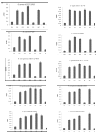Antibacterial activity of plasma from crocodile (Crocodylus siamensis) against pathogenic bacteria
- PMID: 22846342
- PMCID: PMC3490821
- DOI: 10.1186/1476-0711-11-22
Antibacterial activity of plasma from crocodile (Crocodylus siamensis) against pathogenic bacteria
Abstract
Background: The Siamese crocodile (Crocodylus siamensis) is a critically endangered species of freshwater crocodiles. Crocodilians live with opportunistic bacterial infection but normally suffer no adverse effects. They are not totally immune to microbial infection, but their resistance thereto is remarkably effective. In this study, crude and purified plasma extracted from the Siamese crocodile were examined for antibacterial activity against clinically isolated, human pathogenic bacterial strains and the related reference strains.
Methods: Crude plasma was prepared from whole blood of the Siamese crocodile by differential sedimentation. The crude plasma was examined for antibacterial activity by the liquid growth inhibition assay. The scanning electron microscopy was performed to confirm the effect of crude crocodile plasma on the cells of Salmonella typhi ATCC 11778. Effect of crude crocodile plasma on cell viability was tested by MTT assay. In addition, the plasma was purified by anion exchange column chromatography with DEAE-Toyopearl 650 M and the purified plasma was tested for antibacterial activity.
Results: Crude plasma was prepared from whole blood of the Siamese crocodile and exhibited substantial antibacterial activities of more than 40% growth inhibition against the six reference strains of Staphylococcus aureus, Salmonella typhi, Escherichia coli, Vibrio cholerae, Pseudomonas aeruginosa, and Staphylococcus epidermidis, and the four clinical isolates of Staphylococcus epidermidis, Pseudomonas aeruginosa, Salmonella typhi, and Vibrio cholerae. Especially, more than 80% growth inhibition was found in the reference strains of Salmonella typhi, Vibrio cholerae, and Staphylococcus epidermidis and in the clinical isolates of Salmonella typhi and Vibrio cholerae. The effect of the crude plasma on bacterial cells of Salmonella typhi, a certain antibacterial material probably penetrates progressively into the cytoplasmic space, perturbing and damaging bacterial membranes. The effect of the crude plasma was not toxic by the yellow tetrazolium bromide (MTT) assay using a macrophage-like cell, RAW 264.7. The pooled four fractions, designated as fractions D1-D4, were obtained by column chromatography, and only fraction D1 showed growth inhibition in the reference strains and the clinical, human pathogenic isolates.
Conclusions: The crude and purified plasma from the Siamese crocodile significantly showed antibacterial activity against pathogenic bacteria and reference strains by damage cell membrane of target bacterial cells. From the MTT assay, the Siamese crocodile plasma was not cytotoxic to the cells.
Figures





Similar articles
-
Isolation and characterisation of crocosin, an antibacterial compound from crocodile (Crocodylus siamensis) plasma.Anim Sci J. 2010 Jun;81(3):393-401. doi: 10.1111/j.1740-0929.2010.00752.x. Anim Sci J. 2010. PMID: 20597898
-
Characterization of the novel antibacterial peptide Leucrocin from crocodile (Crocodylus siamensis) white blood cell extracts.Dev Comp Immunol. 2011 May;35(5):545-53. doi: 10.1016/j.dci.2010.12.011. Epub 2010 Dec 22. Dev Comp Immunol. 2011. PMID: 21184776
-
Design and synthesis of cationic antibacterial peptide based on Leucrocin I sequence, antibacterial peptide from crocodile (Crocodylus siamensis) white blood cell extracts.J Antibiot (Tokyo). 2014 Mar;67(3):205-12. doi: 10.1038/ja.2013.114. Epub 2013 Nov 6. J Antibiot (Tokyo). 2014. PMID: 24192554
-
Potential of crocodile blood as a medication and dietary supplement: A systemic review.Clin Exp Pharmacol Physiol. 2021 Aug;48(8):1043-1058. doi: 10.1111/1440-1681.13524. Epub 2021 May 29. Clin Exp Pharmacol Physiol. 2021. PMID: 33987869
-
Cell membrane-coated nanoparticles: An emerging antibacterial platform for pathogens of food animals.Front Vet Sci. 2023 Mar 6;10:1148964. doi: 10.3389/fvets.2023.1148964. eCollection 2023. Front Vet Sci. 2023. PMID: 36950535 Free PMC article. Review.
Cited by
-
Immunological properties of oxygen-transport proteins: hemoglobin, hemocyanin and hemerythrin.Cell Mol Life Sci. 2017 Jan;74(2):293-317. doi: 10.1007/s00018-016-2326-7. Epub 2016 Aug 12. Cell Mol Life Sci. 2017. PMID: 27518203 Free PMC article. Review.
-
Antimicrobial peptides in reptiles.Pharmaceuticals (Basel). 2014 Jun 10;7(6):723-53. doi: 10.3390/ph7060723. Pharmaceuticals (Basel). 2014. PMID: 24918867 Free PMC article.
-
Crocodile blood supplementation protects vascular function in diabetic mice.Food Prod Process Nutr. 2021;3(1):19. doi: 10.1186/s43014-021-00066-w. Epub 2021 Aug 3. Food Prod Process Nutr. 2021. PMID: 40477401 Free PMC article.
-
The Komodo dragon (Varanus komodoensis) genome and identification of innate immunity genes and clusters.BMC Genomics. 2019 Aug 30;20(1):684. doi: 10.1186/s12864-019-6029-y. BMC Genomics. 2019. PMID: 31470795 Free PMC article.
-
Protective Effect of Crocodile Hemoglobin and Whole Blood Against Hydrogen Peroxide-Induced Oxidative Damage in Human Lung Fibroblasts (MRC-5) and Inflammation in Mice.Inflammation. 2017 Feb;40(1):205-220. doi: 10.1007/s10753-016-0471-7. Inflammation. 2017. PMID: 27838796
References
Publication types
MeSH terms
Substances
LinkOut - more resources
Full Text Sources
Medical

